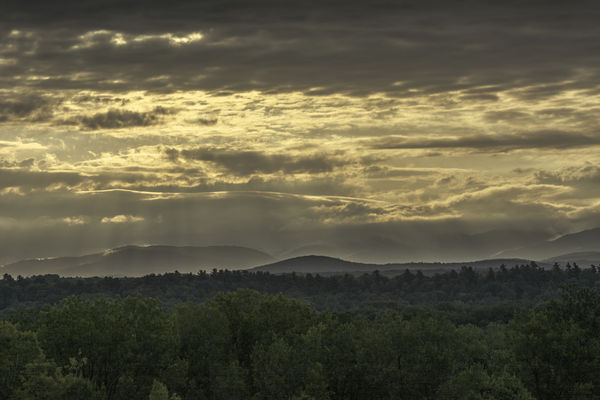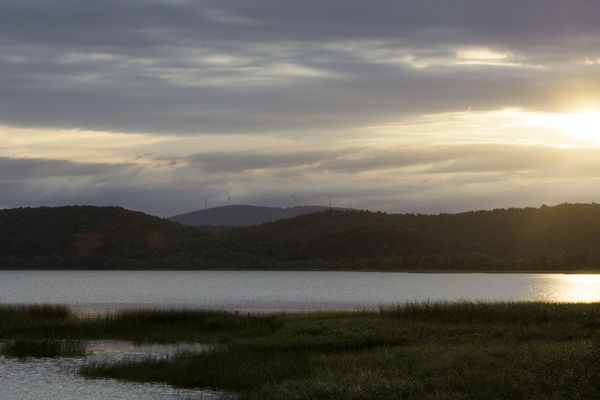Advice as to how to remove or avoid these colored lines
Sep 12, 2017 06:55:04 #
All,
I would appreciate some help with how to improve this image.
Here are the particulars: In the foreground trees (all foreground greens for that matter), there appear to be lines going across the picture horizontally, and regardless of what I do, I cannot remove them. I have tried numerous methods using Photoshop CC, NIK tools and ON1 tools, but those lines persist. As you can see, the lighting was diffuse with lots of clouds, and the foreground was various shades of green. Can anyone enlighten me as to how to either get rid of them in PP, or what I could have done to avoid them in the first place? I have other shots from a similar vantage point during the same session with the same camera and lens that do not display this characteristic... those were done at 1/160, f/11, and ISO 160. This does not seem like noise, but it may very well be.
Constructive assistance / analysis is appreciated.
Tech Specs:
Nikon D7100 with Nikkor 70-300mm f/4.5-5.6 VRII
1/2500 sec, f/8, ISO 100, 95MM
Shot in RAW format
I would appreciate some help with how to improve this image.
Here are the particulars: In the foreground trees (all foreground greens for that matter), there appear to be lines going across the picture horizontally, and regardless of what I do, I cannot remove them. I have tried numerous methods using Photoshop CC, NIK tools and ON1 tools, but those lines persist. As you can see, the lighting was diffuse with lots of clouds, and the foreground was various shades of green. Can anyone enlighten me as to how to either get rid of them in PP, or what I could have done to avoid them in the first place? I have other shots from a similar vantage point during the same session with the same camera and lens that do not display this characteristic... those were done at 1/160, f/11, and ISO 160. This does not seem like noise, but it may very well be.
Constructive assistance / analysis is appreciated.
Tech Specs:
Nikon D7100 with Nikkor 70-300mm f/4.5-5.6 VRII
1/2500 sec, f/8, ISO 100, 95MM
Shot in RAW format
Sep 12, 2017 07:14:43 #
Zooming in on sky I see similar artifacts. Seems to be noise. Please post one that doesn't show such.
Sep 12, 2017 07:31:12 #
ecobin wrote:
Zooming in on sky I see similar artifacts. Seems to be noise. Please post one that doesn't show such.
Thanks ecobin... this is another shot taken during the same outing with the same gear within just a few minutes of the original.
1/160, f/11, ISO 160, 86mm
Sep 12, 2017 07:33:29 #
If ISO 100 and a shutter speed of 1/2500 is correct, it is probably grossly over processed! Without looking at exit that would be my guess.
Sep 12, 2017 07:43:36 #
Good morning. I did not read any comments.
So my independent analysis of the lines in your picture, in its foreground, tells me the lines result from embedded noise.
I say so because in Adobe Camera Raw, in the Detail panel under Noise Reduction, by moving the Luminance sliders, I could reduce these lines. But then of course the detail in the foreground started to blur significantly.
By moving the sliders, with the image at 100 percent for viewing your work, you could reach a compromise acceptable to you.
Know that if dark enough, the foreground will fool the eye enough to obscure faint the horizontal lines.
Part of the remedy involves using a camera with good performance handling noise.
As a Canon shooter, I've found the Canon EOS 6D Mark 1 shows very little if any noise up to ISO 2000. Nikon may have a similar product.
BTW: I notice you shot the image in the JPEG file format. Shooting in the RAW file format could you give your more latitude in reducing noise in ACR.
Good luck.
So my independent analysis of the lines in your picture, in its foreground, tells me the lines result from embedded noise.
I say so because in Adobe Camera Raw, in the Detail panel under Noise Reduction, by moving the Luminance sliders, I could reduce these lines. But then of course the detail in the foreground started to blur significantly.
By moving the sliders, with the image at 100 percent for viewing your work, you could reach a compromise acceptable to you.
Know that if dark enough, the foreground will fool the eye enough to obscure faint the horizontal lines.
Part of the remedy involves using a camera with good performance handling noise.
As a Canon shooter, I've found the Canon EOS 6D Mark 1 shows very little if any noise up to ISO 2000. Nikon may have a similar product.
BTW: I notice you shot the image in the JPEG file format. Shooting in the RAW file format could you give your more latitude in reducing noise in ACR.
Good luck.
VTMatwood wrote:
All, br br I would appreciate some help with how ... (show quote)
Sep 12, 2017 07:55:10 #
VTMatwood wrote:
Thanks ecobin... this is another shot taken during the same outing with the same gear within just a few minutes of the original.
1/160, f/11, ISO 160, 86mm
1/160, f/11, ISO 160, 86mm
The second is much cleaner. It's definitely noise which could be due to post processing. Check the original raw photo for such lines.
Sep 12, 2017 08:26:06 #
Thanks all. I did shoot the image in RAW, and I am surprised that at ISO 100 there is that much noise. In the original photo posted, I have done no post processing. I was unaware that I could post a RAW file to the forum. I can do that if it will provide additional detail. I'll try some different levels of noise reduction, but the softness that introduces makes the image somewhat unacceptable. I have read that Topaz Denoise is the cat's arse for reducing or eliminating noise. Is it worth the $79?
Sep 12, 2017 11:50:05 #
Cannot say about Topaz Denoise. My experience tells me, however, that you may buy salesmanship instead of a useful fix.
Further, you can do a lot of manual noise reduction in Adobe Camera Raw with good results.
My 2 cents: Plug-ins offer an easy solution for lazy or inexperienced users.
I stopped using plug-ins for noise reduction in favor of ACR.
Good luck.
Further, you can do a lot of manual noise reduction in Adobe Camera Raw with good results.
My 2 cents: Plug-ins offer an easy solution for lazy or inexperienced users.
I stopped using plug-ins for noise reduction in favor of ACR.
Good luck.
VTMatwood wrote:
Thanks all. I did shoot the image in RAW, and I a... (show quote)
Sep 13, 2017 06:45:11 #
I recently returned from a trip during which I took over 3,000 photos. As I started looking at them on the computer, many of the images were horribly corrupted by vertical line, areas of blackness or red, etc. Before I allowed myself to plummet into grief I realized that none of these aberrations had shown up on the camera viewing screen. I switched to a different card reader, and the images were fine.
So - the question I have is: do these lines show up in the image when you observe it in-camera? If you used a card reader, try downloading the image directly from the camera with a cable. Just a thought.
So - the question I have is: do these lines show up in the image when you observe it in-camera? If you used a card reader, try downloading the image directly from the camera with a cable. Just a thought.
Sep 13, 2017 07:30:52 #
sb wrote:
I recently returned from a trip during which I too... (show quote)
Thanks for the pointer sb! I will look at that after work today. Hopefully that is the case here. I have not looked in-camera at these, and my care reader is built into the PC itself... so I'll take a different approach and maybe be rid of the lines.
Sep 13, 2017 10:10:44 #
I'm betting that the original image was way under exposed and that you had to bring up the exposure in post causing a huge amount of noise. Even when you shoot raw, only so much can be done with an image when it's not exposed properly. If this is not the case, then next time take several images. Film is cheap for these digital cameras. Shoot away.
Sep 13, 2017 11:11:02 #
What about the very high shutter speed? On the second photo with a much lower speed, you don't see the lines. Could that alone have been the problem?
Sep 13, 2017 12:17:09 #
It looks like the shadows have been significantly boosted to make trees visible. This kind of noise is inevitable when the shadows are lightened beyond some limit. The shadows were underexposed. You probably could not have exposed correctly for the shadows and for the bright sky both in one exposure.
If you'll forgive me for getting technical, here's how it works:
In a JPEG, you have 8 bits of data. (In raw, you may have 12 or 14 or more, but the principle will be the same.)
When we take a picture with an electronic device, the photons are reduced to numbers in a file.
In 8 bits, a numeric value of 0 will be pure black, and 255 pure white.
Shadows are low numbers, highlights high numbers.
All electronic systems have a small amount of noise in them. They get better every year, but it is impossible to eliminate entirely, even in theory.
Let's say, for illustration, that the noise could be plus or minus one.
Plus or minus one in shadows with a numeric value of 10 or 12 see a bigger percentage change than do highlights with values of 200+.
This is why noise shows in the shadows first.
If you take noisy shadows and boost them to higher values, you boost the noise too.
If you take noisy highlights and reduce them to lower values, you reduce the noise too.
This is why people advise exposing to the right. As long as the highlights are not blocked, darkening a slightly overexposed picture yields better results than brightening an underexposed one.
If you'll forgive me for getting technical, here's how it works:
In a JPEG, you have 8 bits of data. (In raw, you may have 12 or 14 or more, but the principle will be the same.)
When we take a picture with an electronic device, the photons are reduced to numbers in a file.
In 8 bits, a numeric value of 0 will be pure black, and 255 pure white.
Shadows are low numbers, highlights high numbers.
All electronic systems have a small amount of noise in them. They get better every year, but it is impossible to eliminate entirely, even in theory.
Let's say, for illustration, that the noise could be plus or minus one.
Plus or minus one in shadows with a numeric value of 10 or 12 see a bigger percentage change than do highlights with values of 200+.
This is why noise shows in the shadows first.
If you take noisy shadows and boost them to higher values, you boost the noise too.
If you take noisy highlights and reduce them to lower values, you reduce the noise too.
This is why people advise exposing to the right. As long as the highlights are not blocked, darkening a slightly overexposed picture yields better results than brightening an underexposed one.
Sep 13, 2017 13:21:52 #
VTMatwood wrote:
All, br br I would appreciate some help with how ... (show quote)
You forgot to mention your ISO setting, as you show a huge amount of color noise!
Sep 13, 2017 13:39:37 #
htbrown wrote:
It looks like the shadows have been significantly ... (show quote)
As a former Software Engineer, I appreciate the technical aspects of your explanation. The image has not had any PP done on it, so I am guessing that I simply did not expose properly for the scene that I was capturing. I assume that a scene such as this would be a candidate for bracketing or HDR? Thanks for the deep dive!
If you want to reply, then register here. Registration is free and your account is created instantly, so you can post right away.








